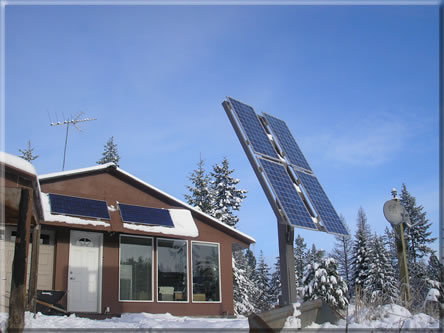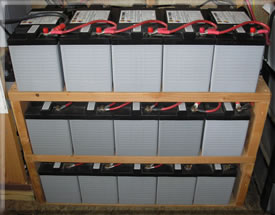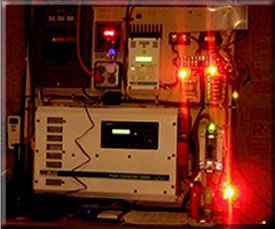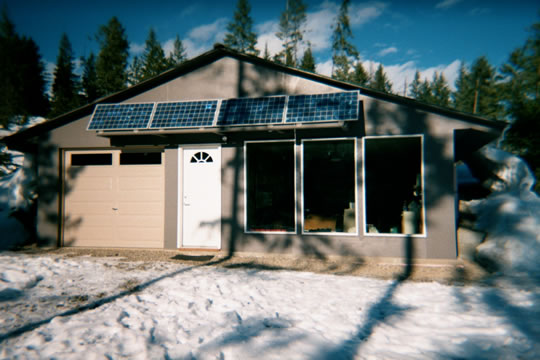| This
efficient solar energy powered home uses six 80 watt solar panels (2
now on the house and 4 on the adjustable mount shown below), a Trace 60
amp charge controller, a Trace 2500 watt true sine wave inverter, and
fifteen 105 AmpHour batteries. With a little conservation and replacing
the power hungry appliances (like dryers, heaters, electric stoves,
etc.) with gas or other alternatives, I have all the electrical
conveniences of modern living without the electric bills and no
connection or dependency on the utility power grid. In the winter,
sometimes heavy snow takes down some power lines & I watch on TV
that my neighbors are without power. :)
|
|
|
|
| With wood heat and no greedy electric
appliances, this system runs a 10 cubic foot refrigerator, a desktop
computer with efficient LCD monitor, a 27 inch Energy Star compliant
color TV, a 1200 watt microwave oven, and assorted other lights and
devices. In the summer when I produce more power than I normally use, I
have enough energy to run a 5000 BTU Air Conditioner for the 1 or 2
hours a day that I need it when it gets over about 95 degrees F. The
earth sheltered design (click the small pictures for more views) keeps
it pretty cool most of the time. Usually, my ceiling fan is all that is
required.
|
|
| I have been using between 60 & 80 KWH (KiloWattHours) of
electricity per month. When I was hooked up to utility power and did not
really know anything about conservation, my KWH usage was closer to 500
! Look at your KWH usage on your electric bills and you will see the
results that conservation and more efficient appliances can produce. A
family of 4 would probably require 16 or more panels but conservation
would still be part of the equation. Check out About Solar Power for some examples of larger system costs. Also the System Sizing Estimator can calculate the number of solar panels and batteries needed for a wide range of configuations using simple one click choices.
|
|
 |
|
UPDATE: The trees casting shadows on the
house mounted solar panels (which is a no-no) have since been cut down
and the panels remounted on the seasonally adjustable mount shown on the
left. This has increased output over 25% with adjustments 4 times per
year. Since the trees were cut down, I later bought 2 more panels and
mounted them back on the house since I still had the wiring in place.
With a total of 6 solar panels and 15 AGM 105 AmpHour batteries I have
plenty of! |
|
|
| In eastern Washington state, from about mid February thru about mid
November I receive more than enough power from the sun. During the worst
winter months (Dec-Jan) I run a generator for 45-60 minutes a day on
overcast days to bulk
charge the batteries. If I was connected to the utility grid, I could
actually sell power back to the utility company during the peak summer
power production months. Check out the Solar Radiation chart to get an idea of the amount of sunshine you could expect for your area.
|
|
| The cost for this system including a
7000 Watt electric start AC Generator, the new solar array mount, and
the added solar panels & batteries comes to about $10,000 but could
have been set up with less expensive components for around $6,500. That
may sound like a lot of money but... NO electric bills! And energy
independence!
|
|
| Here is a full view of the battery bank. These are 12 volt 105
AmpHour AGM (absorbent glass mat) lead acid batteries designed for
alternative energy applications, all wired in parallel. With 1575 total
AmpHour capacity and using 125 to 200 AmpHours per day, I could run for
quite a few days. However, lead acid batteries like to be fully charged
so I usually don't use more than 300 to 350 AmpHours before I recharge.
This is known as shallow cycling and will greatly increase battery life.
With this technique I expect to get 10 years or more from my batteries.
On overcast days with little solar energy, I can run the generator for
an hour or so and bring the battery bank pretty close to full. I wait
for the sun to top them off.
|
|
 |
|
|
 |
|
This is the original installation of all the components in
the temporary power center. Shown is the AC breaker panel, system
monitor, charge controller, 12 volts DC power fuse blocks, inverter, and
main 250 amp circuit breaker. Eventually I plan to locate all the
equipment elsewhere and use remote control panels and monitor displays
only. Although I am used to it now, the inverter does buzz a little when
it operates.
I took this night time shot just to enhance all the led
running lights. They make great night lights and are not really as
bright as they look in the photo which I modified somewhat...
|
|
























0 comments:
Post a Comment